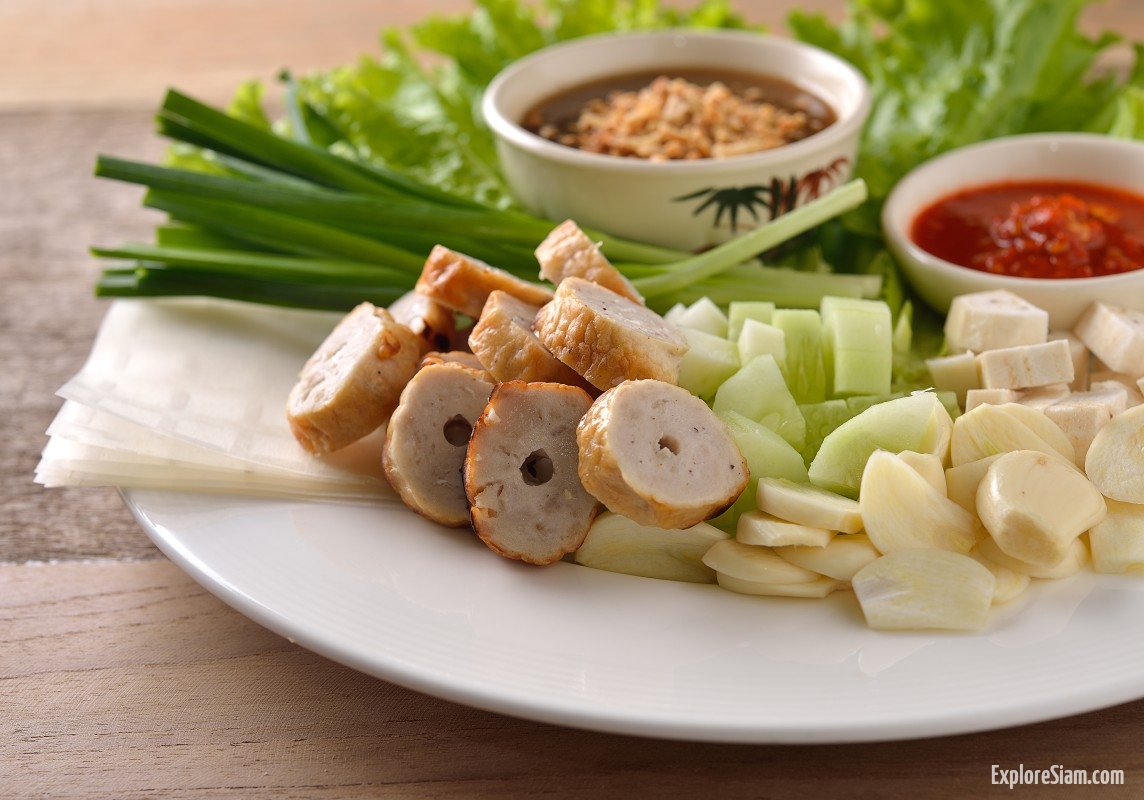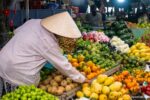Vietnamese cuisine is a vibrant tapestry of flavors, techniques, and cultural influences, woven together over centuries to create a culinary tradition that is both deeply rooted in history and ever-evolving. From the lively street markets of Saigon to the serene rice paddies of the Red River Delta, the food of Vietnam is a journey through the senses, offering a complex interplay of taste, texture, and aroma that reflects the country’s rich cultural heritage and natural bounty.
The Foundations of Vietnamese Cuisine
At the heart of Vietnamese cuisine lies a philosophy of balance, where each dish is crafted to harmonize the five fundamental taste elements: sweet, salty, sour, bitter, and umami. This meticulous attention to balance is evident in the use of fresh, natural ingredients that are carefully selected and prepared to enhance their inherent flavors. Rice, the staple of the Vietnamese diet, serves as the foundation for many meals, providing a neutral canvas that allows the vibrant flavors of accompanying dishes to shine. Whether in the form of steamed rice, rice noodles, or rice paper, this versatile grain is a symbol of sustenance and tradition.
Herbs and vegetables play a pivotal role in Vietnamese cooking, not merely as garnishes but as integral components that contribute to the flavor profile and nutritional value of each dish. Mint, cilantro, basil, and lemongrass are among the most commonly used herbs, adding freshness and complexity to dishes like pho, the iconic noodle soup that has become synonymous with Vietnamese cuisine. The use of these herbs, combined with the bold flavors of fish sauce, lime, and chili, creates a dynamic interplay that is both refreshing and satisfying.
Regional Variations: A Culinary Journey
Vietnam’s diverse geography has given rise to distinct regional culinary traditions, each with its own unique flavor profile and cooking style. In the north, where the climate is cooler and the seasons more pronounced, the cuisine tends to be subtle and refined, with an emphasis on the natural flavors of the ingredients. Hanoi, the capital city, is renowned for its elegant and understated dishes, such as bun cha, a dish of grilled pork served with vermicelli noodles, fresh herbs, and a tangy dipping sauce. The use of freshwater fish, seafood, and hearty vegetables reflects the region’s proximity to rivers and lakes.
Central Vietnam, particularly the city of Hue, is known for its bold and spicy cuisine, which is heavily influenced by the region’s royal history. The food here is characterized by intricate preparations and complex flavor combinations, often featuring a mix of meat, seafood, and vegetables. Dishes like bun bo Hue, a spicy beef noodle soup, and banh xeo, a crispy pancake filled with shrimp and pork, exemplify the region’s vibrant culinary tradition. The use of chili peppers, fermented shrimp paste, and a variety of pickled vegetables adds depth and intensity to the flavors.
In the south, the cuisine takes on a sweeter and more tropical character, reflecting the region’s warm climate and fertile lands. The Mekong Delta, known as the “rice bowl” of Vietnam, produces an abundance of fruits, vegetables, and rice, which are central to the local diet. Coconut milk is a common ingredient in southern Vietnamese dishes, lending a rich and creamy texture to curries, soups, and desserts. Ho Chi Minh City, the largest city in the south, is a bustling metropolis where street food culture thrives. Here, you can find a wide array of dishes, from banh mi, a French-inspired sandwich filled with pickled vegetables and meats, to fresh spring rolls wrapped in translucent rice paper.
Influence and Innovation
The cuisine of Vietnam has been shaped by a myriad of cultural influences, from the ancient traditions of indigenous peoples to the more recent impact of Chinese, French, and American colonialism. Each of these influences has left its mark on Vietnamese food, contributing to its rich and diverse culinary landscape. The Chinese introduced ingredients like soy sauce, noodles, and stir-frying techniques, which have been seamlessly integrated into Vietnamese cuisine. The French colonial period brought new ingredients and cooking methods, such as the use of baguettes, coffee, and pâté, which have become staples in Vietnamese food culture.
One of the most iconic examples of this cultural fusion is the banh mi, a sandwich that combines a crispy French baguette with an array of Vietnamese fillings, including pickled carrots, daikon, cilantro, and various meats or tofu. This dish perfectly encapsulates the Vietnamese ability to adapt and innovate, creating something entirely new while maintaining a deep connection to its culinary roots. The banh mi has become a global phenomenon, with variations found in cities around the world, each one a testament to the enduring appeal of this simple yet flavorful creation.
In recent years, Vietnamese chefs have begun to experiment with contemporary interpretations of traditional dishes, incorporating new ingredients and techniques to create innovative culinary experiences. These modern twists on classic recipes are often inspired by global food trends, yet they remain firmly rooted in the foundational principles of Vietnamese cuisine — balance, freshness, and flavor. In upscale restaurants and street food stalls alike, you can find dishes that push the boundaries of traditional Vietnamese cooking while honoring the essence of the cuisine.
The Ritual of Dining
In Vietnam, food is more than just sustenance; it is a central part of social and cultural life. Meals are often shared, with dishes placed in the center of the table for everyone to enjoy. This communal style of dining reflects the importance of family and community in Vietnamese culture, where food is a way to connect with others and celebrate life’s moments, both big and small. The act of sharing food fosters a sense of togetherness, creating bonds that transcend the boundaries of language and tradition.
The presentation of food is also a key aspect of Vietnamese dining, with great care taken to ensure that each dish is visually appealing as well as delicious. The vibrant colors of fresh herbs, the intricate arrangements of ingredients, and the delicate garnishes all contribute to the overall dining experience. In Vietnamese culture, the appearance of a dish is just as important as its taste, and the aesthetic appeal of the food enhances the enjoyment of the meal.
Street Food: The Heartbeat of Vietnamese Cuisine
Vietnamese street food is a culinary treasure trove that offers an authentic taste of the country’s diverse and dynamic food culture. From the bustling streets of Hanoi to the vibrant alleys of Ho Chi Minh City, street food vendors serve up an incredible array of dishes, each one a reflection of the local flavors and traditions. Street food is an integral part of daily life in Vietnam, providing quick, affordable, and delicious meals to people from all walks of life.
Pho, the beloved noodle soup, is perhaps the most famous of Vietnam’s street foods. Served at roadside stalls and in bustling markets, pho is a dish that exemplifies the simplicity and depth of Vietnamese cooking. The broth, made from simmered bones, herbs, and spices, is clear yet rich in flavor, and is poured over rice noodles, thinly sliced meat, and a handful of fresh herbs. The dish is finished with a squeeze of lime and a dash of chili, allowing each diner to customize their bowl to their taste.
But pho is just the beginning. Street food in Vietnam encompasses a wide range of dishes, from banh mi sandwiches and fresh spring rolls to sweet treats like che, a dessert made with coconut milk, beans, and sticky rice. Each region has its own specialties, and exploring the street food scene is one of the best ways to experience the local culture and flavors. The vibrant atmosphere of the street markets, the sizzle of food cooking on open grills, and the aromas of fresh herbs and spices create an immersive sensory experience that is uniquely Vietnamese.
Vietnamese Cuisine and the Art of Balance
Vietnamese cuisine is often described as an art form, where balance is the key to creating dishes that are both complex and harmonious. This balance is not only about the flavors but also about the textures, temperatures, and colors of the food. In every Vietnamese meal, there is a careful consideration of how each element interacts with the others to create a holistic dining experience.
For example, a traditional Vietnamese meal might include a combination of soft, chewy, and crispy textures, with hot and cold dishes served side by side. The interplay of these elements creates a dynamic and engaging eating experience, where each bite offers something new and exciting. The balance of flavors — sweet, sour, salty, bitter, and umami — is achieved through the use of fresh herbs, spices, and condiments, which are carefully combined to create a symphony of taste.
This emphasis on balance extends beyond individual dishes to the meal as a whole. In Vietnamese culture, a meal is considered incomplete if it does not include all five taste elements, as well as a variety of textures and temperatures. This holistic approach to dining reflects the Vietnamese belief in the importance of harmony and balance in all aspects of life, including food.
Exploring Vietnamese Cuisine: A Traveler’s Guide
For travelers, Vietnamese cuisine offers a rich and rewarding exploration of the country’s culture and history. Whether you are wandering through the chaotic streets of Hanoi, dining on a riverside terrace in Hoi An, or enjoying a home-cooked meal in a rural village, each bite is an opportunity to connect with the people and traditions of Vietnam. The flavors are bold yet nuanced, the ingredients are fresh and vibrant, and the experience is one of discovery and delight.
As you journey through Vietnam, take the time to savor the food, learn about the ingredients, and appreciate the care and skill that goes into each dish. Vietnamese cuisine is more than just a meal — it is a celebration of life, a reflection of history, and a testament to the enduring spirit of the Vietnamese people. Whether you are enjoying a bowl of pho in a bustling street market or a multi-course feast in a fine dining restaurant, Vietnamese food is sure to leave a lasting impression on your palate and your soul.





